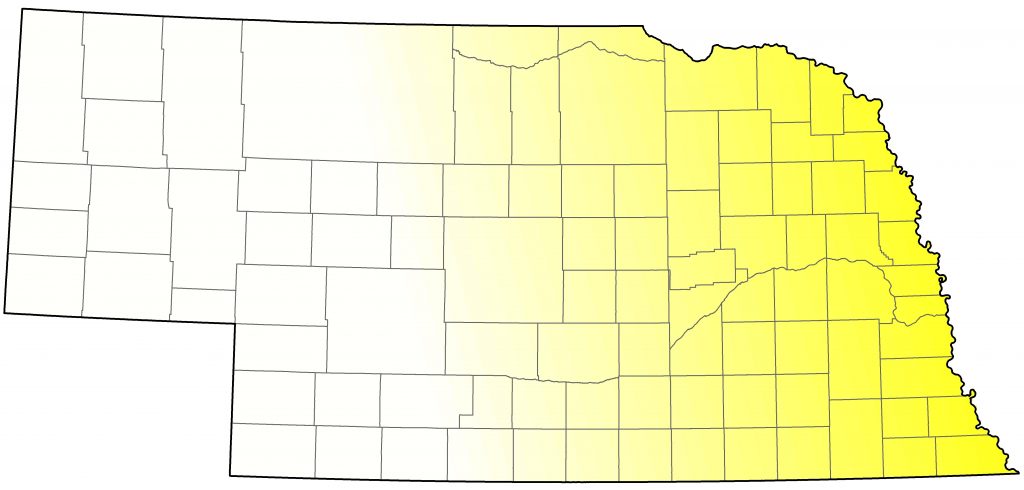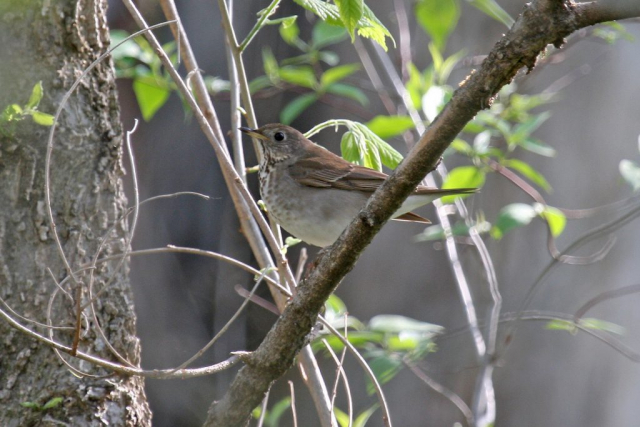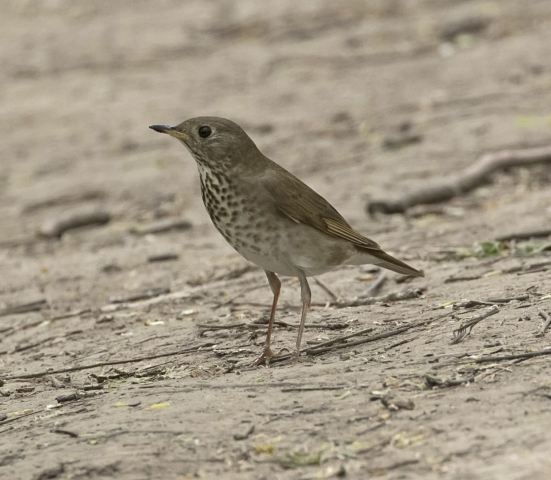Catharus minimus aliciae
Status: Uncommon regular spring migrant east, rare east-central, rare casual west-central and west. Rare casual fall migrant statewide.

Documentation: Specimen: UNSM ZM11018, 11 May 1910 South Bend, Cass Co.
Taxonomy: Two subspecies are recognized (AviList 2025): aliciae, breeding from Alaska to northern Alberta and Labrador, and minimus, breeding in Newfoundland and northeast Quebec.
Nebraska birds are aliciae.
Spring: Apr 29, 29, 29 <<<>>> May 23, 23, 24
Earlier dates are 13 Apr 2008 Otoe Co, and 27 Apr 2017 Cass Co.
Later dates are 26 May 2020 Merrick Co, 26 May 2020 Wayne Co, 30 May 2024 Sarpy Co, and 5 Jun (Jorgensen 2012).
Migration is in May. Numbers are quite variable year to year as detailed here, with higher numbers reported in the 2020s. Spring 2015 saw numerous reports, involving a total of some 26 individuals, west to Hamilton Co, where one was found 14 May. There were 40+ reports of at least 50 individuals in 2016, including counts of 10-11 at Fontenelle Forest, Sarpy Co 13-14 May. Between 45 and 60 were reported during May in 2020, 2023, and 2024, and 69 in 2025.
Although there are several spring reports of Gray-cheeked Thrush in the heavily birded Colorado Front Range, likely due to a concentration of observers (Steven Mlodinow, personal communication; eBird.org, accessed Jun 2024), we consider most of the 40+ Nebraska Panhandle reports through 2020 inconclusive. There are only 14 west and west central documented records, six of these in northeastern Cherry Co (eBird.org, accessed Jun 2024), and five in 2025 alone. The west and west central records away from Valentine are of two at different locations in Cheyenne Co 7 May 2025, Kimball Co 7 May 2025, Logan Co 10 May 2025, Gotte Park, Kimball Co 13 May 2024, one banded at Cedar Point Biological Station, Keith Co 15 May 1997, 20 May 2025 Scotts Bluff Co, and one photographed near Potter, Cheyenne Co 21 May 2020.
This species is said to migrate later in spring than any other Catharus thrush except Bicknell’s Thrush (Whitaker et al 2020), although Nebraska data do not support this conclusion. Earliest Nebraska reports supported by photographs are 1, 2, and 2 May (eBird.org, accessed 18 Aug 2023), comparable to early dates listed above.
- High counts: 55 in Sarpy Co 11 May 1996 (including 20 at Fontenelle Forest and 15 at Cedar Island), 10-11 at Fontenelle Forest 13-14 May 2016, and 6 in Seward Co 21 May 2003.
Fall: There are about 38 reports, most undocumented. Reports with supporting information are 25 Aug 1934 Lincoln Co (Tout 1947), 2 Sep 2017 Butler Co, 3 Sep 1974 Dawes Co (Rosche 1982), 8 Sep 2020 Lancaster Co, 8 Sep 2024 Sioux Co, 9 Sep 2016 Lancaster Co, 13 Sep 2013 Lake Ogallala, Keith Co, 25 Sep 2007 Douglas Co, 10 Oct 2014 Sarpy Co, and 14 Oct 1938 Lincoln Co (Tout 1947).
Migration occurs in Sep.
This species is far less numerous in fall, despite its wider distribution at that time. A possible explanation for this may be inferred from a study on Swainson’s Thrush by Ruegg and Smith (2002), which, due to an artifact of late Pleistocene glaciations, evolved an elliptical migration pattern that largely avoids the central USA in fall (see Swainson’s Thrush account). Ruegg and Smith (2002) suggested that other Catharus thrushes, including Hermit and Gray-cheeked, may have evolved the same pattern.
Images
Abbreviations
UNSM: University of Nebraska State Museum
Literature Cited
AviList Core Team, 2025. AviList: The Global Avian Checklist, v2025. https://doi.org/10.2173/avilist.v2025.
Jorgensen, J.G. 2012. Birds of the Rainwater Basin, Nebraska. Nebraska Game and Parks Commission, Lincoln, Nebraska, USA.
Rosche, R.C. 1982. Birds of northwestern Nebraska and southwestern South Dakota, an annotated checklist. Cottonwood Press, Crawford, Nebraska, USA.
Ruegg, K.C., and T.B. Smith. 2002. Not as the crow flies: A historical explanation for circuitous migration in Swainson’s thrush (Catharus ustulatus). The Proceedings of the Royal Society of London B 269: 1375–1381.
Tout, W. 1947. Lincoln County birds. Published by the author, North Platte, Nebraska, USA.
Whitaker, D.M., I G. Warkentin, J.P.B. McDermott, P.E. Lowther, C.C. Rimmer, B. Kessel, S.L. Johnson, and W.G. Ellison. 2020. Gray-cheeked Thrush (Catharus minimus), version 1.0. In Birds of the World (P. G. Rodewald, Editor). Cornell Lab of Ornithology, Ithaca, NY, USA. https://doi.org/10.2173/bow.gycthr.01.
Recommended Citation
Silcock, W.R., and J.G. Jorgensen. 2025. Gray-cheeked Thrush (Catharus minimus). In Birds of Nebraska — Online. www.BirdsofNebraska.org
Birds of Nebraska – Online
Updated 21 Jul 2025


